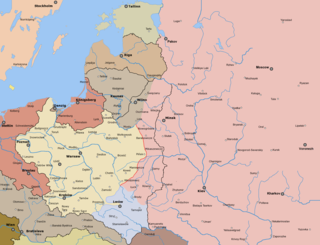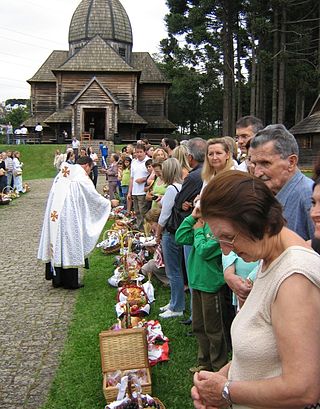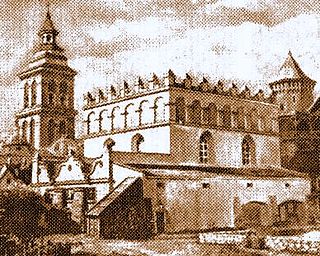Related Research Articles

Ruthenian and Ruthene are exonyms of Latin origin, formerly used in Eastern and Central Europe as common ethnonyms for East Slavs, particularly during the late medieval and early modern periods. The Latin term Rutheni was used in medieval sources to describe all Eastern Slavs of the Grand Duchy of Lithuania, as an exonym for people of the former Kievan Rus', thus including ancestors of the modern Belarusians, Rusyns and Ukrainians. The use of Ruthenian and related exonyms continued through the early modern period, developing several distinctive meanings, both in terms of their regional scopes and additional religious connotations.

Galicia is a historical and geographic region spanning what is now southeastern Poland and western Ukraine, long part of the Polish–Lithuanian Commonwealth. It covers much of the other historic regions of Red Ruthenia and Lesser Poland.

The West Ukrainian People's Republic or West Ukrainian National Republic, known for part of its existence as the Western Oblast of the Ukrainian People's Republic, was a short-lived polity that controlled most of Eastern Galicia from November 1918 to July 1919. It included the cities of Lviv, Ternopil, Kolomyia, Drohobych, Boryslav, Stanislaviv and right-bank Przemyśl, and claimed parts of Bukovina and Carpathian Ruthenia. Politically, the Ukrainian National Democratic Party dominated the legislative assembly, guided by varying degrees of Greek Catholic, liberal and socialist ideology. Other parties represented included the Ukrainian Radical Party and the Christian Social Party.

The Kingdom of Galicia and Lodomeria, also known as Austrian Galicia or colloquially Austrian Poland, was a constituent possession of the Habsburg monarchy in the historical region of Galicia in Eastern Europe. The crownland was established in 1772. The lands were annexed from the Polish-Lithuanian Commonwealth as part of the First Partition of Poland. In 1804 it became a crownland of the newly proclaimed Austrian Empire. From 1867 it was a crownland within the Cisleithanian or Austrian half of the dual monarchy of Austria-Hungary. It maintained a degree of provincial autonomy. Its status remained unchanged until the dissolution of the monarchy in 1918.

The Polish–Ukrainian War, from November 1918 to July 1919, was a conflict between the Second Polish Republic and Ukrainian forces. The conflict had its roots in ethnic, cultural and political differences between the Polish and Ukrainian populations living in the region, as Poland and both Ukrainian republics were successor states to the dissolved Russian and Austrian empires. The war started in Eastern Galicia after the dissolution of the Austro-Hungarian Empire and spilled over into Chełm Land and Volhynia (Wołyń) regions formerly belonging to the Russian Empire, which were both claimed by the Ukrainian State and the Ukrainian People's Republic. Poland re-occupied the disputed territory on 18 July 1919.
The Organization of Ukrainian Nationalists was a Ukrainian nationalist organization established in 1929 in Vienna, uniting the Ukrainian Military Organization with smaller, mainly youth, radical nationalist right-wing groups. The OUN was the largest and one of the most important far-right Ukrainian organizations operating in the interwar period on the territory of the Second Polish Republic.

Galician Jews or Galitzianers are members of the subgroup of Ashkenazi Jews originating in the Levant having developed in the diaspora of the Kingdom of Galicia and Lodomeria and Bukovina from contemporary western Ukraine and from south-eastern Poland. Galicia proper, which was inhabited by Ruthenians, Poles and Jews, became a royal province within Austria-Hungary after the Partitions of Poland in the late 18th century. Galician Jews primarily spoke Yiddish.

Lviv is an administrative center in western Ukraine with more than a millennium of history as a settlement, and over seven centuries as a city. Prior to the creation of the modern state of Ukraine, Lviv had been part of numerous states and empires, including, under the name Lwów, Poland and later the Polish–Lithuanian Commonwealth; under the name Lemberg, the Austrian and later Austro-Hungarian Empires; the short-lived West Ukrainian People's Republic after World War I; Poland again; and the Soviet Union. In addition, both the Swedes and the Ottoman Turks made unsuccessful attempts to conquer the city.

Lemko-Rusyn People's Republic, often known also as the Lemko-Rusyn Republic, just the Lemko Republic, or the Florynka Republic, was a short-lived state founded on 5 December 1918 in the aftermath of World War I and the dissolution of the Austro-Hungarian Empire. It was centered on Florynka, a village in the south-east of present-day Poland. Being Russophile, its intent was unification with a democratic Russia and was opposed to a union with the West Ukrainian People's Republic. A union with Russia proved impossible, so the Republic then attempted to join Subcarpathian Rus' as an autonomous province of Czechoslovakia. This, however, was opposed by the then governor of Subcarpathian Rus', Gregory Žatkovich.
Galician Russophilia or Moscophiles were participants in a cultural and political movement largely in the Kingdom of Galicia and Lodomeria, Austria-Hungary. This ideology emphasized that since the Eastern Slavic people of Galicia were descendants of the people of Kievan Rus' (Ruthenians), and followers of Eastern Christianity, they were thus a branch of the Russian people. The movement was part of the larger Pan-Slavism that was developing in the late 19th century. Russophilia was largely a backlash against Polonisation and Magyarisation that was largely blamed on the landlords and associated with Roman Catholicism.

The Polish minority in Ukraine officially numbers about 144,130, of whom 21,094 (14.6%) speak Polish as their first language. The history of Polish settlement in current territory of Ukraine dates back to 1030–31. In Late Middle Ages, following the extinction of the Rurik dynasty in 1323, the Kingdom of Poland extended east in 1340 to include the lands of Przemyśl and in 1366, Kamianets-Podilskyi. The settlement of Poles became common there after the Polish–Lithuanian peace treaty signed in 1366 between Casimir III the Great of Poland, and Liubartas of Lithuania.

The history of the Ukrainian minority in Poland dates back to the Late Middle Ages, preceding the 14th century Galicia–Volhynia Wars between Casimir III the Great of Poland, and Liubartas of Lithuania. Following the extinction of the Rurikid dynasty in 1323, the Polish Kingdom extended further east in 1340 to include the lands of Przemyśl and in 1366, Kamianets-Podilskyi. After the Union of Lublin (1569), principalities of Galicia and Western Volhynia became, what is known as, the Ruthenian Voivodeship of the Polish Crown, while the rest of Red Ruthenia together with Kiev came under Lithuanian control. The Polish borders reached as far east as Zaporizhia, and Poltava.

Ukrainian Brazilians are Brazilian citizens born in Ukraine, or Brazilians of Ukrainian descent who remain connected, in some degree, to Ukrainian culture.

On the basis of a secret clause of the Molotov–Ribbentrop Pact, the Soviet Union invaded Poland on September 17, 1939, capturing the eastern provinces of the Second Polish Republic. Lwów, the capital of the Lwów Voivodeship and the principal city and cultural center of the region of Galicia, was captured and occupied by September 22, 1939 along with other provincial capitals including Tarnopol, Brześć, Stanisławów, Łuck, and Wilno to the north. The eastern provinces of interwar Poland were inhabited by an ethnically mixed population, with ethnic Poles as well as Polish Jews dominant in the cities. These lands now form the backbone of modern Western Ukraine and West Belarus.

The Ukrainian National Democratic Alliance, (UNDO) was the largest Ukrainian political party in the Second Polish Republic, active in Western Ukraine. It dominated the mainstream political life of the Ukrainian minority in Poland, which with almost 14% of Poland's population was the largest minority.
The Ukrainian Radical Party, (URP), founded in October 1890 as Ruthenian-Ukrainian Radical Party and based on the radical movement in western Ukraine dating from the 1870s, was the first modern Ukrainian political party with a defined program, mass following, and registered membership. It advocated socialism, increased rights for Ukrainian peasants, and secularism.
On August 18, 1914, the Russian Empire invaded the Austrian Crownland of Galicia. On August 19, the Imperial Russian Army defeated the Austro-Hungarian Army, advanced 280–300 kilometers into the territory of Austria-Hungary and captured most of eastern Galicia. The principal city, Lemberg fell into Russian hands on September 3. Eastern Galicia had a population of approximately 4.8 million people.

The Eastern Catholic clergy of the Ukrainian Greek Catholic Church were a hereditary tight-knit social caste that dominated Ukrainian society in Western Ukraine from the late eighteenth until the mid-twentieth centuries, following the reforms instituted by Joseph II, Emperor of Austria. Because, like their Eastern Orthodox brethren, married men in the Ukrainian Catholic Church could become priests, they were able to establish "priestly dynasties", often associated with specific regions, for many generations. Numbering approximately 2,000-2,500 by the 19th century, priestly families tended to marry within their group, constituting a tight-knit hereditary caste. In the absence of a significant culturally and politically active native nobility, and enjoying a virtual monopoly on education and wealth within western Ukrainian society, the clergy came to form that group's native aristocracy. The clergy adopted Austria's role for them as bringers of culture and education to the Ukrainian countryside. Most Ukrainian social and political movements in Austrian-controlled territory emerged or were highly influenced by the clergy themselves or by their children. This influence was so great that western Ukrainians were accused by their Polish rivals of wanting to create a theocracy in western Ukraine. The central role played by the Ukrainian clergy or their children in western Ukrainian society would weaken somewhat at the end of the nineteenth century but would continue until the Soviet Union forcibly dissolved the Ukrainian Greek Catholic Church in Ukrainian territories in the mid-twentieth century.

Eastern Galicia was the heartland of the medieval Kingdom of Galicia–Volhynia, currently spread over the provinces of Lviv, Ivano-Frankivsk, and Ternopil in modern western Ukraine. Along with Poles and Ukrainians, Jews were one of the three largest ethnic groups in Eastern Galicia with almost 900,000 people by 1910. From the late 18th century until the early 20th century eastern Galicia had the largest concentration of Jews of any region in Europe.
With the arrival of the Hungarians into the heart of the Central European Plain around 899, Slavic tribes of Vistulans, White Croats, and Lendians found themselves under Hungarian rule. In 955 those areas north of the Carpathian Mountains constituted an autonomous part of the Duchy of Bohemia and remained so until around 972, when the first Polish territorial claims began to emerge. This area was mentioned in 981, when Vladimir the Great of Kievan Rus' claimed the area on his westward way. In the 11th century the area belonged to Poland, then reverted to Kievan Rus'. However, at the end of the 12th century the Hungarian claims to the principality turned up. Finally Casimir III of Poland annexed it in 1340–1349. Low Germans from Prussia and Middle Germany settled parts of northern and western Galicia from the 13th to 18th centuries, although the vast majority of the historic province remained independent from German and Austrian rule.
References
- 1 2 3 4 5 6 7 Orest Subtelny. (1988). Ukraine: a History. Toronto: University of Toronto Press, pp. 324-325 and pp.437-438.
- ↑ Andrii Krawchuk. (1989). "Andriy Sheptytsky and the Ethics of Christian Social Action." In Paul Robert Magocsi (Ed.). Morality and Reality: the Life and Times of Andrei Sheptytsky. Edmonton: Canadian Institute of Ukrainian Studies, University of Alberta. pg. 250 and pg. 264
- 1 2 3 4 Paul Robert Magocsi. (1996). A History of Ukraine. Toronto: University of Toronto Press, pg. 442 and pg. 589
- ↑ Agriculture in the Black Sea Region Ukraine: The agricultural sector continues to hold its leading position in the domestic economy
- ↑ Ukrainian Weekly. Leadership Conference focuses on Ukrainian Americans' expanding horizons. by Yaro Bihun. October 19, 1997
- 1 2 Official website of the Ukrainian National Credit Union Association Annual Meeting 2008
- ↑ Canadian Credit Union Report Archived 2009-03-22 at the Wayback Machine